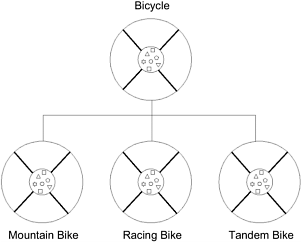What Is Inheritance?
Generally speaking, objects are defined in terms of classes. You know a lot about an object by knowing its class. Even if you don't know what a penny-farthing is, if I told you it was a bicycle, you would know that it had two wheels, handle bars, and pedals.
Object-oriented systems take this a step further and allow classes to be defined in terms of other classes. For example, mountain bikes, racing bikes, and tandems are all kinds of bicycles. In object-oriented terminology, mountain bikes, racing bikes, and tandems are all subclasses of the bicycle class. Similarly, the bicycle class is the superclass of mountain bikes, racing bikes, and tandems. This relationship is shown in Figure 36.
Figure 36. The hierarchy of bicycle classes.

Each subclass inherits state (in the form of variable declarations) from the superclass. Mountain bikes, racing bikes, and tandems share some states: cadence, speed, and the like. Also, each subclass inherits methods from the superclass. Mountain bikes, racing bikes, and tandems share some behaviors: braking and changing pedaling speed, for example.
However, subclasses are not limited to the state and behaviors provided to them by their superclass. Subclasses can add variables and methods to the ones they inherit from the superclass. Tandem bicycles have two seats and two sets of handle bars; some mountain bikes have an extra set of gears with a lower gear ratio.
Subclasses can also override inherited methods and provide specialized implementations for those methods. For example, if you had a mountain bike with an extra set of gears, you would override the "change gears" method so that the rider could use those new gears.
You are not limited to just one layer of inheritance. The inheritance tree, or class hierarchy, can be as deep as needed. Methods and variables are inherited down through the levels. In general, the farther down in the hierarchy a class appears, the more specialized its behavior.
The Object class is at the top of class hierarchy, and each class is its descendant (directly or indirectly). A variable of type Object can hold a reference to any object, such as an instance of a class or an array. Object provides behaviors that are required of all objects running in the Java Virtual Machine. For example, all classes inherit Object's toString method, which returns a string representation of the object. The section Managing Inheritance (page 204) covers the Object class in detail.
Inheritance offers the following benefits:
- Subclasses provide specialized behaviors from the basis of common elements provided by the superclass. Through the use of inheritance, programmers can reuse the code in the superclass many times.
- Programmers can implement superclasses called abstract classes that define "generic" behaviors. The abstract superclass defines and may partially implement the behavior, but much of the class is undefined and unimplemented. Other programmers fill in the details with specialized subclasses.
Getting Started
- About the Java Technology
- How Will Java Technology Change My Life?
- First Steps (Win32)
- First Steps (UNIX/Linux)
- First Steps (MacOS)
- A Closer Look at HelloWorld
- Questions and Exercises
- Code Samples
Object-Oriented Programming Concepts
- What Is an Object?
- What Is a Message?
- What Is a Class?
- What Is Inheritance?
- What Is an Interface?
- How Do These Concepts Translate into Code?
- Summary
- Questions and Exercises
- Code Samples
Language Basics
Object Basics and Simple Data Objects
Classes and Inheritance
Interfaces and Packages
Handling Errors Using Exceptions
- What Is an Exception?
- The Catch or Specify Requirement
- Catching and Handling Exceptions
- Specifying the Exceptions Thrown by a Method
- How to Throw Exceptions
- Runtime Exceptions The Controversy
- Advantages of Exceptions
- Summary of Exceptions
- Questions and Exercises
- Code Samples
Threads: Doing Two or More Tasks at Once
- What Is a Thread?
- Using the Timer and TimerTask Classes
- Customizing a Threads run Method
- The Life Cycle of a Thread
- Understanding Thread Priority
- Synchronizing Thread
- Grouping Threads
- Summary of Threads
- Questions and Exercises
- Code Samples
I/O: Reading and Writing
- Overview of I/O Streams
- Using the Streams
- Object Serialization
- Working with Random Access Files
- And the Rest…
- Summary of Reading and Writing
- Questions and Exercises
- Code Samples
User Interfaces That Swing
- Overview of the Swing API
- Your First Swing Program
- Example Two: SwingApplication
- Example Three: CelsiusConverter
- Example Four: LunarPhases
- Example Five: VoteDialog
- Layout Management
- Threads and Swing
- Visual Index to Swing Components
- Summary
- Questions and Exercises
- Code Samples
Appendix A. Common Problems and Their Solutions
- Appendix A. Common Problems and Their Solutions
- Getting Started Problems
- General Programming Problems
- Applet Problems
- User Interface Problems
Appendix B. Internet-Ready Applets
- Appendix B. Internet-Ready Applets
- Overview of Applets
- AWT Components
- Taking Advantage of the Applet API
- Practical Consideration of Writing Applets
- Finishing an Applet
- Swing-Based Applets
- Code Samples
Appendix C. Collections
- Appendix C. Collections
- Introduction
- Interfaces
- Implementations
- Algorithms
- Custom Implementations
- Interoperability
Appendix D. Deprecated Thread Methods
- Appendix D. Deprecated Thread Methods
- Why Is Thread.stop Deprecated?
- Why Are Thread.suspend and Thread.resume Deprecated?
- What about Thread.destroy?
- Why Is Runtime.runFinalizersOnExit Deprecated?
Appendix E. Reference
EAN: 2147483647
Pages: 125
